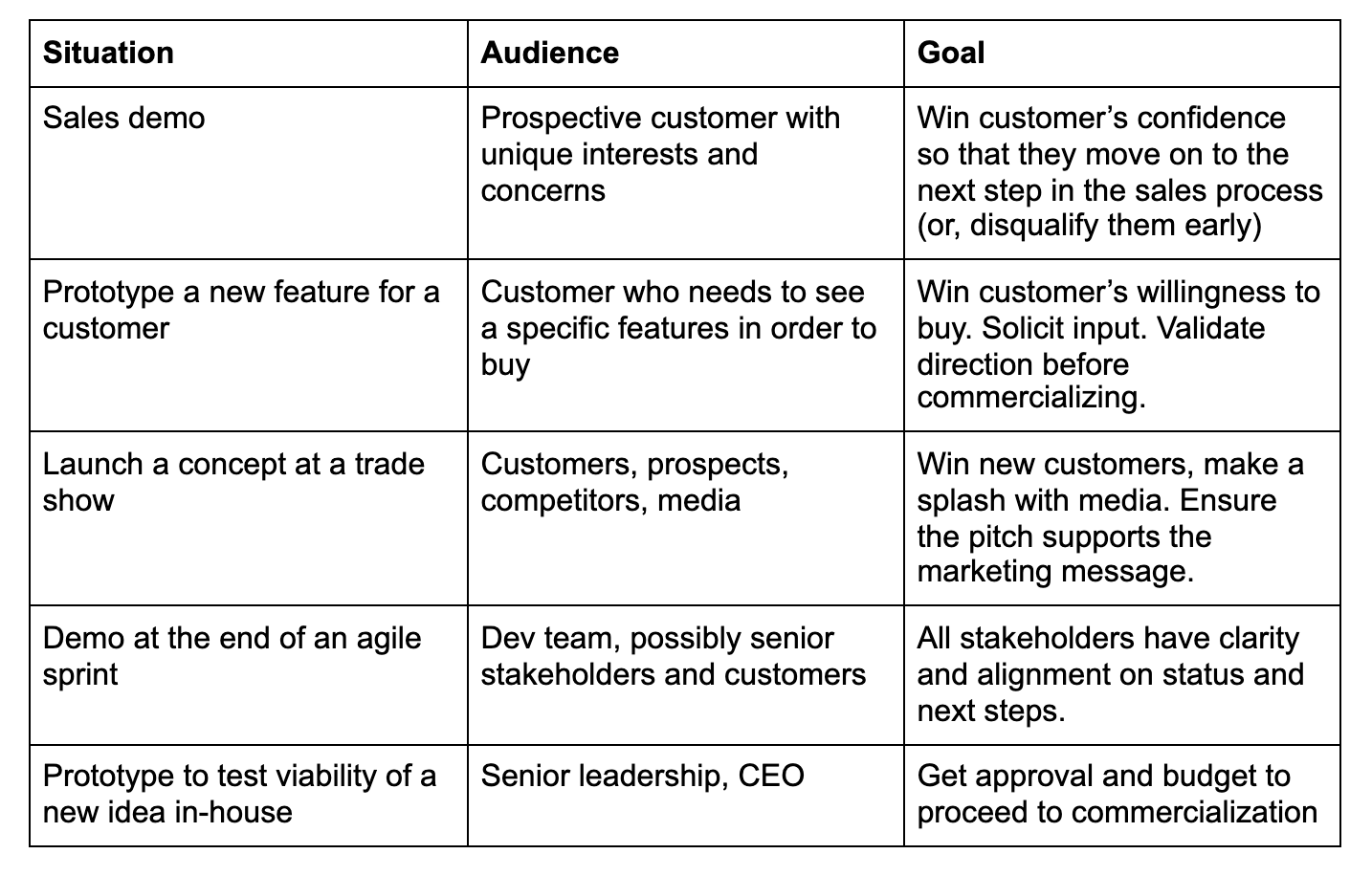How To Give a Digital Transformation Pitch

CMOs and CTOs: 5 Simple Steps
As the CMO, CTO, or VP Product responsible for digital strategy, a big part of your job is show-and-tell, whether pitching a new product or feature to your internal stakeholders, to a customer, or at a trade show. Like it or not, you are the modern-age Don Draper. Give the right pitch and you’ll unlock praise (“That’s exactly what we want!”), revenue, and recognition. Do it wrong and you’ll leave everyone scratching their heads.
This article is a complete guide to pitching digital applications that win over the audience, including how to prototype the right product, position the right demo, and say the right words when you are in the room yourself.
- Get Clear On The Goal
First, any product demo must have a clear objective: when the demo is over, what do you want to happen? It is amazing how even seasoned C-level leaders go into meetings without a clear goal in mind, simply thinking they will talk about the product and see what happens.
The goal is a function of your audience and context. Here are the most common examples:

- Know The Audience
Whatever the goal, the only way to be sure you will achieve it is by understanding the audience. It sounds so obvious, and yet this step again is often not done. The pitch is left mostly to chance, when in fact you need to do as much recon as possible to truly understand what the audience cares about and what needs to happen to achieve the goal.
Customers and prospects are often interested in very specific things about your digital solution:
- Can it meet a very specific use case?
- Does fit into my workflow and integrate with my environment?
- What does it look like? Will it be easy to use?
- Can I see how it is different from other competitors and substitutes?
Internal stakeholders have different needs. A CEO and board will be interested in how the product lines up to the market needs that they see, as well as progress. The exec team will be interested in the product, but also selfishly “What does this mean for my function? What does this mean for my team?”
If you can pinpoint the list of questions they have and what their fears and concerns might be, that gives you a major leg-up on how to present the pitch and demo that will achieve your goal.
- Tell a Story
Humans are wired for stories. We take in information more easily and retain it better when that info is provided as a narrative rather than a long list of facts. So, given your audience and the goal you want to achieve, what is the story you are going to tell?
Digital leaders often think this is the job of marketing and sales. You sell it, we’ll just show the features. FAIL. This is old-school thinking. Today, the digital product IS as much part of marketing as any advertisement or brochure. It’s no wonder software product managers and digital teams are increasingly reporting into the CMO, or into a CTO that is closely working with marketing and sales.
But the weaving the story of your product demo isn’t about wording, it’s about clarity of purpose. Even the most structured engineer can follow this simple, logical mapping exercise:

Just fill in this table on the top 3-5 priorities of the call. Make sure that you can then give the proper context and background to help your audience understand each point, and that you explain it in a logical, coherent sequence. Document it as a high-level script or storyboard.
- It’s Not What You Show, It’s How You Show it
Knowing your audience is also key to choosing what you will show and why. Sometimes a great powerpoint deck is better than a visual demo, especially with an executive audience who may not care much about the product itself as you think. Often the C-level buyers (who are not necessarily users) are less interested in the demo and more interested in getting answers to specific questions about a business case. A flashy demo could be perceived as a distraction.
When it comes to customers who will use the product, whether your goal is to sell or to simply get feedback, a visual is critical. Sometimes a canned video demo will work better, sometimes a live demo, sometimes even an interactive prototype that the person can physically try themselves
Sometimes it’s less about showing the product and more about using tools like personas and journey maps to show that you’ve understood the user.
If you’re not sure, don’t just bombard your audience with everything! People’s attention spans are shorter than ever, and no one wants to sit through a long presentation that misses the mark.
- Digital Pitches are a Team Effort
Often a digital pitch is not put together by just 1 person, but by a team. You might have the CTO, CMO or VP who presides over the call, a Product Manager, a sales engineer or technical specialist, marketing, UX design, and one or more developers who actually put it together (especially if there is custom code). This is where clearly outlining the goal, the audience, and the storyboard is critical, so that everyone involved is on the same page and works swiftly to put the slides, demo, or prototype together.
Too many presentations fall down when the executive has a plan, but doesn’t provide this context and the developers craft the wrong demo that does not correspond to the pitch. Depending on the importance of the goal (winning a customer, making a splash at an event, presenting to the board), having one or more dry-runs is also highly recommended.
In addition, remember that not all developers are created equal! Some developers excel at back-end code, some are excellent at maintaining systems and tracking down bugs, some are fast prototypers, great communicators, or very intuitive when it comes to design and client-facing activity. Needless to say, the dev who is preparing your demo or prototype should be nimble, design-oriented and enjoy prototyping ideas quickly, and you may need to iterate a few times until what you are showing supports the storyboard just right.
Consider a Digital Acceleration Partner
Sound obvious? It is common sense. Yet most CTOs, CMOs and VPs fail to follow even the most basic of these steps, leading to frustrated audiences and missed opportunities. Spending a few hours getting crystal clear on your digital pitch - the goal, the audience, and the storyboard for what you want to say and what you want to show - is simply a must in the new digital world, where communication is everything.
Don’t have the right team in-house to build a digital pitch? Don’t want to distract the devs? Instead, consider a partner like Thinklogic. Thinklogic’s Digital Acceleration and Response Team (DART) specializes in building amazing digital apps for the CMO and CTO, whether a rapid prototype to win over an audience, providing a crack team of modern web and mobile experts, or rescuing an in-house program that is running behind. Located in Culver City, Los Angeles; Thinklogic is your trusted partner for amazing digital applications
How To Give a Digital Transformation Pitch
We believe there is always a more efficient way
Thinklogic has a strong history of successfully developing and bringing to market hundreds of new web-based custom software applications. From concept refinement and business planning, to technology deployment and selling to the end-user, our team has expertise in both technology and marketing.
Innovative Developers
We understand how to build custom solutions fit for the digital age.
Clean and Concise
We want to deliver our message as quickly as possible, without any unnecessary flare.
Business-minded
Creating value for your business is our number one priority - we mean business.









.svg)
